Scouts carry the coffin of a boy during the funeral of people killed in a Saudi-led coalition air strike on a bus in northern in Saada, Yemen. (Reuters/Naif Rahma)
Dahyan, Yemen – The bandage wrapped around Mokhtar al-Jaradi’s head is still soaked in blood.
There are cuts and grazes to his arms and face. But it’s the anguish etched in his dark brown eyes that really speaks of the massacre that unfolded in north Yemen last week.
The eight-year-old was laughing and playing with a group of friends at the front of his school bus while on a day-long field trip organised by a pro-Houthi Islamic seminary.
Some of the older boys who arrived late were made to stand in the aisle. The younger ones jostled for the few seats available.
Mokhtar says all of the 50 children were on board the bus that morning appeared to be in high spirits.
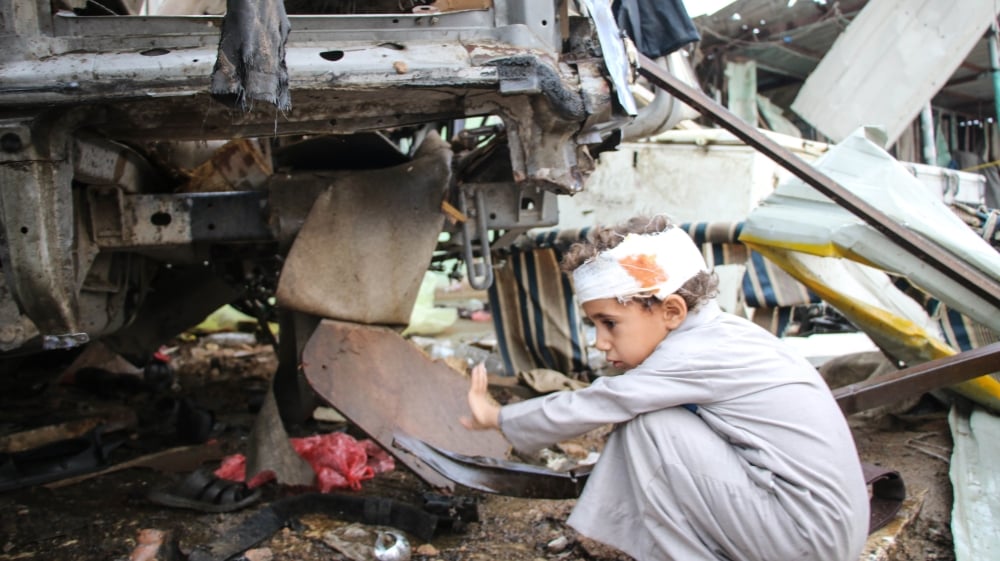
Mokhtar al-Jaradi says he does not want to go to school after so many of his friends were killed. (Ahmad Algohbary/Al Jazeera)
A video taken by one of the boys on the bus, Osama al-Hamran, showed the children excited for the day ahead.
In one clip, the children recited verses from the Quran. In another, they were smiling and giggling.
When the bus sped off, passers-by heard joyful screams as it veered through the dusty, pot-hole ridden roads of Saada province.
After stops at a graveyard for local fighters and a nearby shrine, the bus was supposed to take its young passengers to Saada city for a visit to the ninth-century al-Hadi mosque, a historical site which is venerated by Yemen’s Houthi rebels.
But the children never made it.
What Mokhtar remembers next is a loud explosion, bright red-and-orange colours, then the grisly sight of charred young bodies.
“I saw the explosion, then my ears started ringing,” he told Al Jazeera. His eyes welled up with tears.
“I saw blood, then smoke. And once I saw my friends dying, I began crying.”
Mokhtar lost several friends in the August 9 air raid, which killed 40 children as they stopped for food in Dahyan.
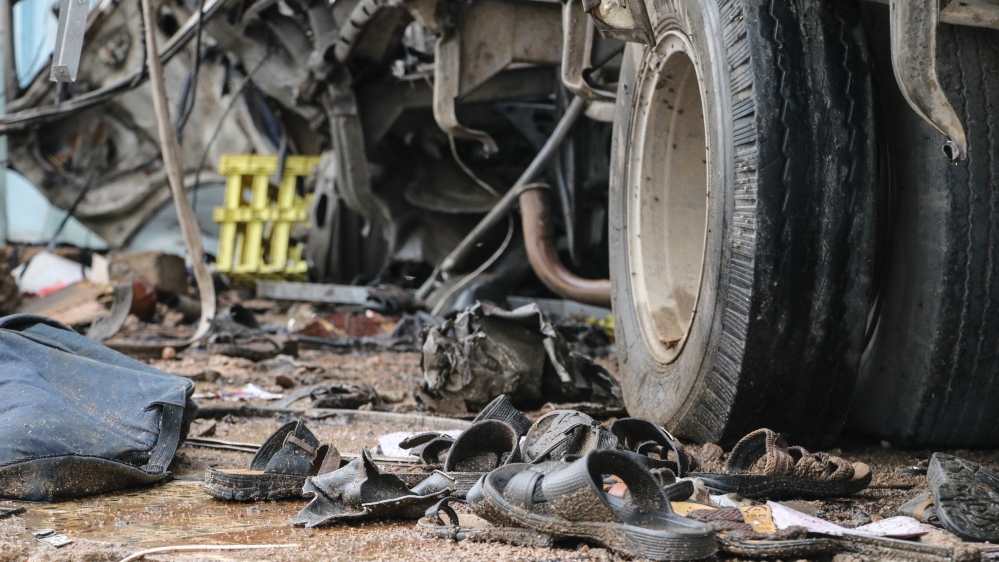
Childrens shoes, sandals and bloodstained UNICEF rucksacks were still at the scene of the air strike. (Ahmad Algohbary/Al Jazeera)
Eleven bystanders were also killed in the attack, which sent shockwaves across the country.
Large protests erupted in the capital, Sanaa, and elsewhere. Local newspapers called the attack one of the worst days in Yemen’s three-year war.
‘The screams kept getting louder and louder’
Ahmed Jaran, owner of a small clothes shop near the site of the blast, said he was greeted by “scenes of sheer horror” as he rushed to help the wounded.
“As I ran through the smoke, the screams just kept getting louder and louder,” he said, standing just metres away from the bombed-out carcass of the school bus.
“Human remains were thrown everywhere, mixed with debris from the explosion. I took as many children as I could to the hospital — but it was 14km away.”
Along with several bloodied children, Jaran picked up Ali, one of his coworkers who was badly injured by the attack.
“When we reached the hospital, several of the children were pronounced dead. So, too, was Ali. I still can’t believe what happened. It feels like a bad dream. I’m still struggling to absorb the events.”
Among the boys who died was Osama, who had been using his smartphone to record a video diary throughout the religious trip.
The videos were found on his phone, which survived the blast, according to the Houthis who sent the footage to Al Jazeera.
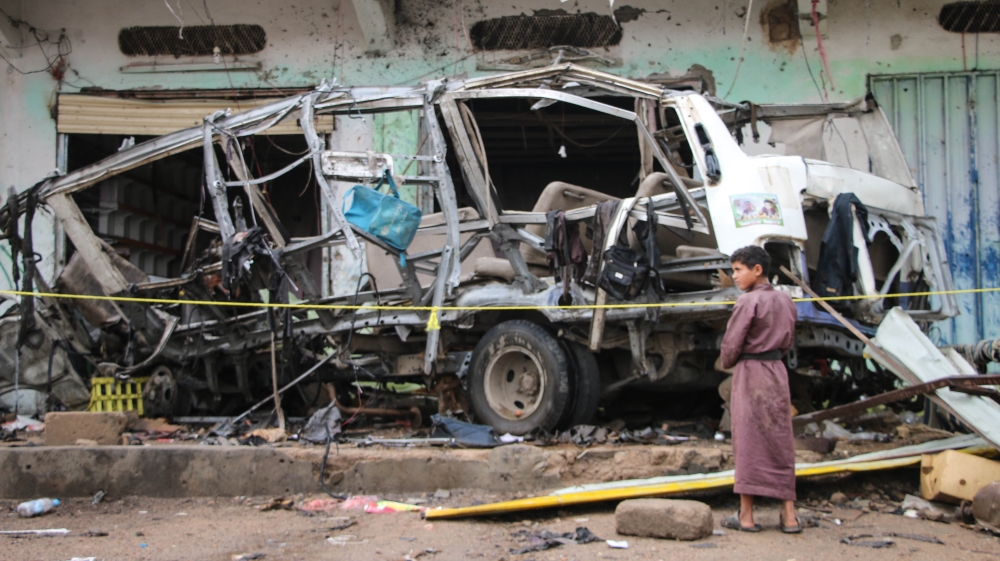
A child stands near the mangled wreckage of the bombed-out school bus. (Ahmad Algohbary/Al Jazeera)
“I am filming!” Osama can be heard yelling in one of the videos, surrounded by children wearing coats over their thobes, a traditional dress for Arab males.
Light-blue UNICEF rucksacks carried by the children could also be seen.
‘Never seen anything like this’
But videos shot in the aftermath of the raid showed a smouldering heap of twisted metal and the lifeless bodies of two boys on the ground.
“I was shocked when I saw the victims,” said Mohammed Ahsan, a 35-year-old doctor at al-Talh hospital in Saada where most of the survivors are being treated.
“I had never seen anything like this before. They were really badly wounded.”
Three days after the attack, victims’ families continued to throng to the scene of the attack, hoping to find the remains of their loved ones.
“I didn’t find any of him,” said Abdelhakim Amir as he searched the wreckage for his son, Ahmed.
“Not his finger, not his bone, not his skull, nothing.”
Saudi Arabia, which, along with the United Arab Emirates, has been bombing Yemen since March 2015, said it would carry out an investigation.
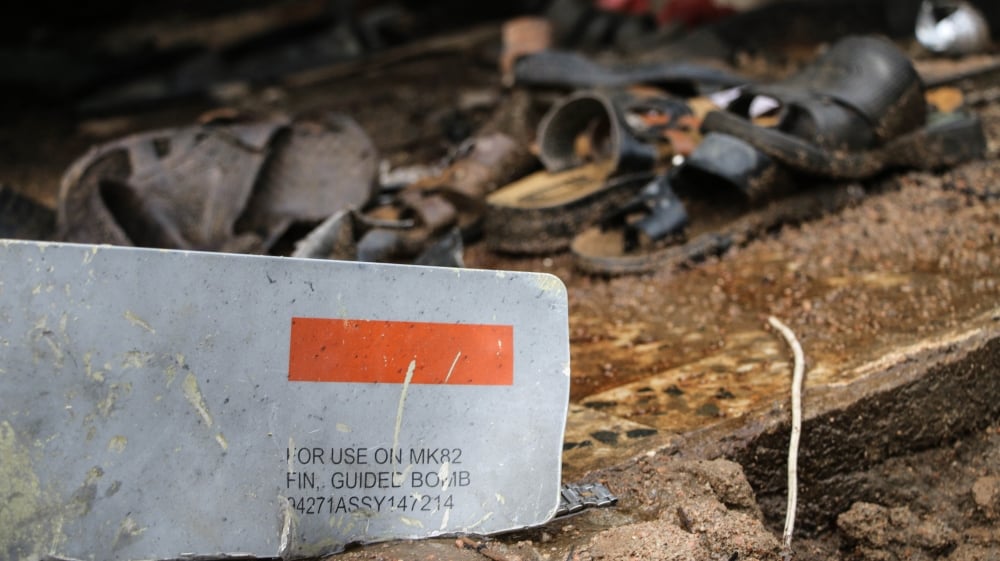
Fragments of the MK-82 bomb were found close the wreckage. (Ahmad Algohbary/Al Jazeera)
But out of the 16 000-plus raids they have launched since the start of the conflict, only a handful have been investigated, despite nearly a third of all bombs hitting civilian targets.
The UN blacklisted the Saudi-UAE alliance last year, for the majority of child deaths and injuries reported in Yemen.
But on the day of the bus attack, Colonel Turki al-Malki, a spokesperson for the alliance, defended the raid, saying his forces hit a “legitimate military target”, which included “operators and planners”.
The Houthis have used the area to launch attacks on the Saudi border and fire missiles into the kingdom and the UAE.
However, on August 10, the alliance said the bombing had been referred for an internal probe after the US — which provides substantial support to the alliance, including intelligence sharing — denounced the killings and called for a “thorough and transparent investigation”.
‘I hate buses’
A few days later, Al Jazeera received an image suggesting a US-made MK-82 bomb was used in the raid. A metal fin, bearing the serial numbers of Lockheed Martin, was found nearby.
The photo has not been independently verified, but fragments of the MK-82 bomb have surfaced repeatedly amid the ongoing war.
The 500-pound bomb was used in a 2016 attack on a community hall hosting a funeral in Sanaa. At least 140 people were killed in that attack.
The Trump administration says it has little control over the targets the alliance chooses to attack, but human right groups say Washington should stop selling aerial bombs to the kingdom in the absence of serious investigations into alleged war crimes.
In the wake of the attack, individual members of Congress called on the US military to clarify its role in the war and investigate whether support for the air raids could render American military personnel“liable under the war crimes act”.
But any investigation will do little to pacify the victims’ families, residents told Al Jazeera.
“I will take revenge on Salman, Mohammed Bin Zayed and Trump,” said Fares al-Razhi, referring to the leaders of Saudi Arabia, the UAE and the US, after his 14-year-old son was killed.
The parents of some of the survivors were also inconsolable.
“I’m waiting on my son to get better, and once he does I will take my revenge on the Saudis,” said Mokhtar’s father. “We will never leave Saada.”
Close to him, his son crouches near the bomb site, still haunted by memories of the attack.
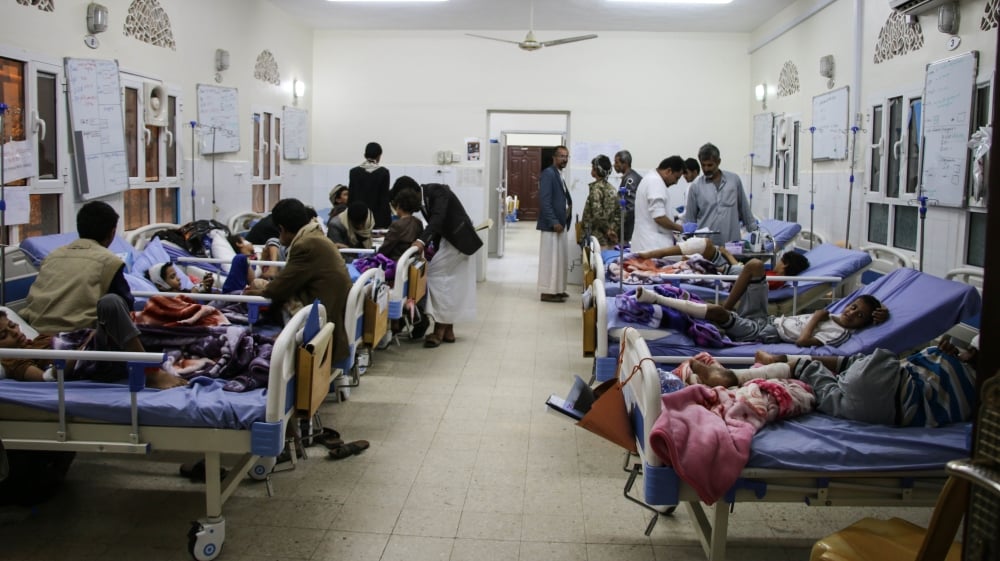
Only 11 of the 51 children who were on the bus survived the attack. (Ahmad Algohbary/Al Jazeera)
“My father says he will buy me toys and get me a new school bag. But I don’t want a new school bag. I hate school bags,” said eight-year-old Mokhtar before adding that his education ended the day his friends died.
“I don’t want to go anywhere near a bus. I hate buses, I hate school and I can’t sleep. I see my friends in my dreams begging me to rescue them.
“So, from now on, I’m going to stay at home.” — Al Jazeera